WORLD CLASS COACHING
40 Small-Sided Games
By Luca Bertolini
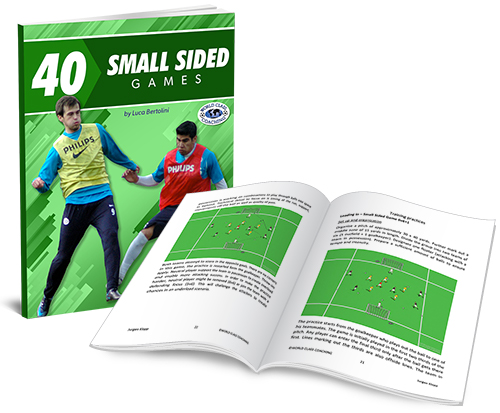
Table of Contents
PART TWO
2v2, 3v3 and 4v4 Small-Sided Games
2 v 2 Exercises (1)

Set-up and Sequence: a 2 v 2 duel is played inside a rectangular space that is positioned in the middle of a bigger rectangular area.
The couple with the ball must allow 1 player receiving out of the smaller area and dribbling back in the middle (1 point), to try to gain another point.
The pass can be directed out of all the sides of the structure. If the defenders win the ball, they must play the same way.
Variation: ask the players to complete a passing sequence in the middle (1point) before playing wide.
Eye on: quick passes, oriented ball control, receiving on the run, focus the defense phase on the players.
2 v 2 Exercises (2)

Set-up and Sequence: the sequence and the objectives are the same of the previous exercise, but the directions of play are different.
The black players must pass wide along the longer sides of the rectangle; if the yellow defenders recover the possession, they must play toward the shorter sides of the structure.
Variation: ask the players to complete a passing sequence in the middle (1point) before playing wide.
Eye on: quick passes, oriented ball control, receiving on the run, focus the defense phase on the player in possession (1 v 1) and on the space to be covered.
2 v 2 Exercises (3)

Set-up and Sequence: a 2 v 2 duel is played inside a rectangular space that is positioned in the middle of a bigger rectangular area.
The couple with the ball must allow 1 player receiving out of the smaller area and along the longer sides first (1 point), and then playing a back pass to complete a triangle combination and to dribble out, overcoming one of the shorter sides of the structure (1 point more).
Variation: ask the players to complete a passing sequence in the middle (1point) before playing wide.
Eye on: quick passes, oriented ball control, receiving on the run, focus the defense phase on the players and on the closure of the passing lanes.
2 v 2 Exercises (4) - after 5 passes (3 v 1)
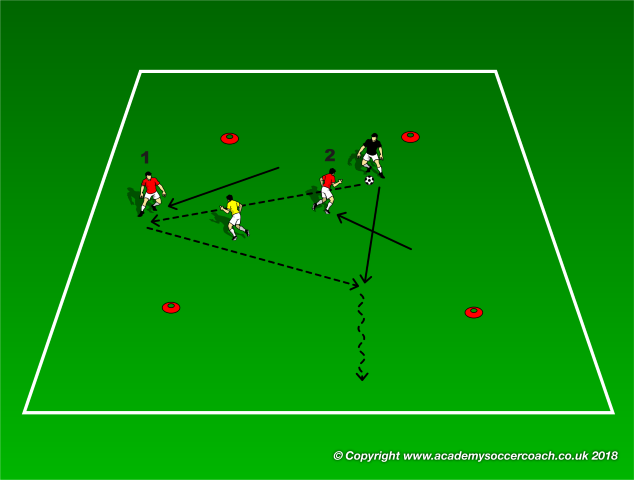
Set-up and Sequence: the practice has the same goal of the previous one; to complete a triangle pass with a wide player to dribble toward one of the shorter sides, after receiving the return pass.
A 3 v 1 duel is played before the final sequence, thanks to the red neutral players (1 and 2). After a fix number of passes, or after a minimum limit of time, one free player runs wide to receive and he becomes attacker; the other red free player becomes defender, re-forming the 2 v 2 duel.
Eye on: quick passes, oriented ball control, receiving on the run, focus the defense phase on the players and on the closure of the passing lanes, and be clever to recognize the role on the pitch.
2 v 2 Exercises (5)
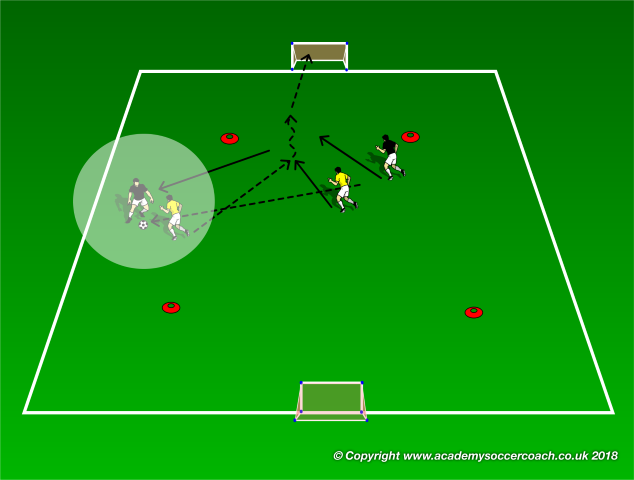
Set-up and Sequence: this last 2 v 2 practice is a progression of the previous ones. The attacking couple must complete the triangle sequence, playing wide and dribbling the ball forward.
If the defending team wins the possession, the move must finished scoring in one of the mini-goals on the end lines of the structure.
Variations:
1) The attacking team must finish toward one mini-goal, playing a triangle combination first
2) The defending team must play the same if the possession is won back
3) The defending team must counter-attack directly to finish
Eye on: quick passes, oriented ball control, receiving on the run, focus the defense phase on the players and on the closure of the passing lanes, quick player transitions to attack and to defend.
3 v 3 Exercises (1)
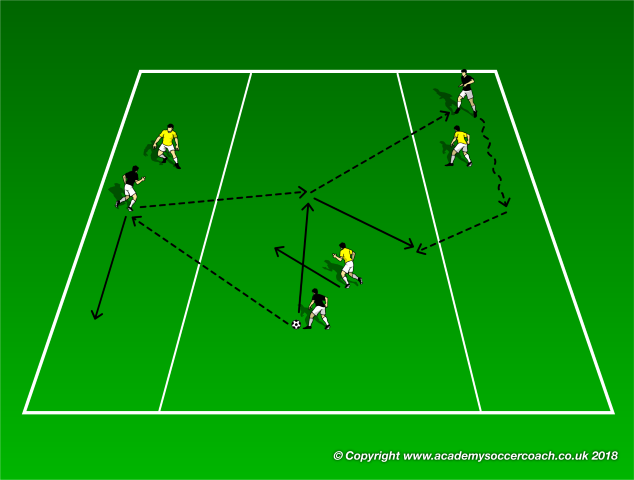
Set-up and Sequence: a 3 v 3 duel is played inside a rectangular space that is divided into three areas vertically; a 1 v 1 duel is played inside each zone.
The goal for the possession team is to distribute the ball from one side the other through the center space, playing upwards and backwards.
If the defenders win the ball, they must play the same way.
Eye on: quick passes combinations, escape the marker, oriented ball control.
3 v 3 Exercises (2)
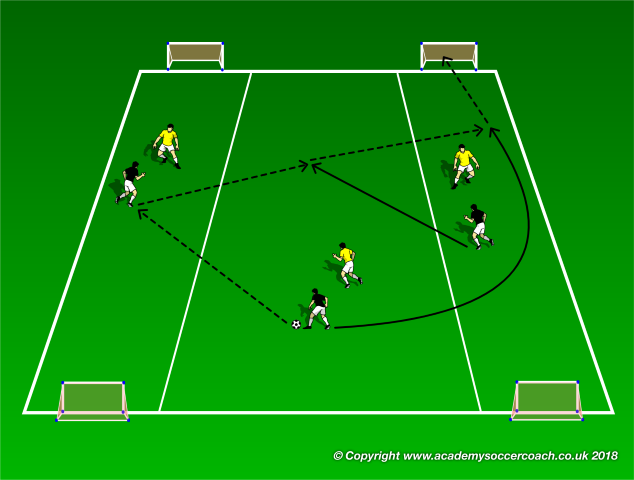
Set-up and Sequence: a 3 v 3 duel is played inside a rectangular space that is divided into three areas vertically; a 1 v 1 duel is played inside each zone. 4 goals are placed as in the picture.
The goal for the possession team is to distribute the ball from one side the other through the center space, scoring in one of the mini-goal to be attacked and exchanging the positions between the center player, who overlaps, and the opposite wide teammate, who runs inside.
If the defenders win the ball, they must play the same way toward the opposite side.
Variations: if the defenders win the possession, a 3 v 3 free duel is played to counter attack.
Eye on: quick passes combinations, escape the marker, oriented ball control.
3 v 3 Exercises (3)
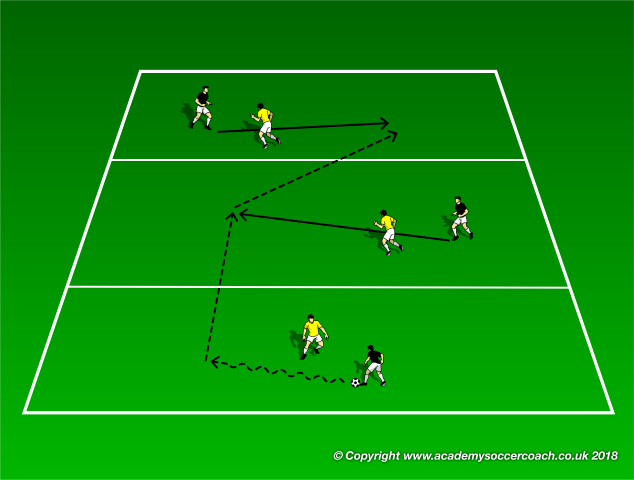
Set-up and Sequence: a 3 v 3 duel is played inside a rectangular space that is divided into three areas horizontally; a 1 v 1 duel is played inside each zone.
The goal for the possession team is to play the ball vertically from the lower side the upper one and backward through the center space.
If the defenders win the ball, they must play the same way.
Eye on: quick passes combinations, escape the marker, oriented ball control, and receive on the run.
3 v 3 Exercises (4)
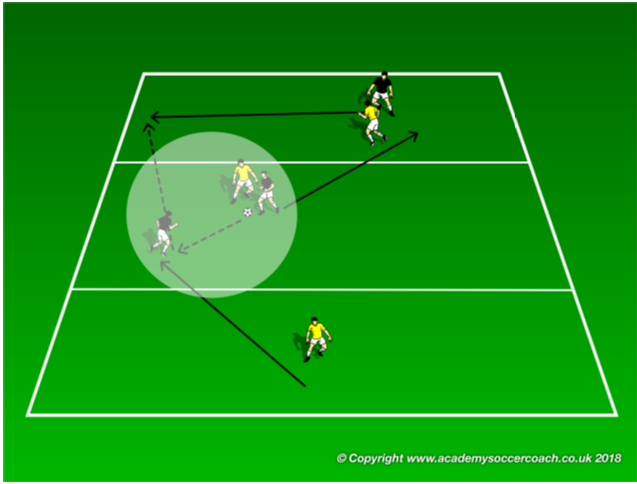
Set-up and Sequence: this exercise is a variation of the previous one to create numerical advantage inside each area.
The goal for the possession team is always to play the ball vertically, from the lower side the upper one and backward through the center space.
Every pass to the next zone must be followed to create a 2 v 1 duel inside each area.
If the defenders win the ball, they must play the same way.
Eye on: quick passes combinations, escape the marker, oriented ball control, and support the teammate.
3 v 3 Exercises (5)
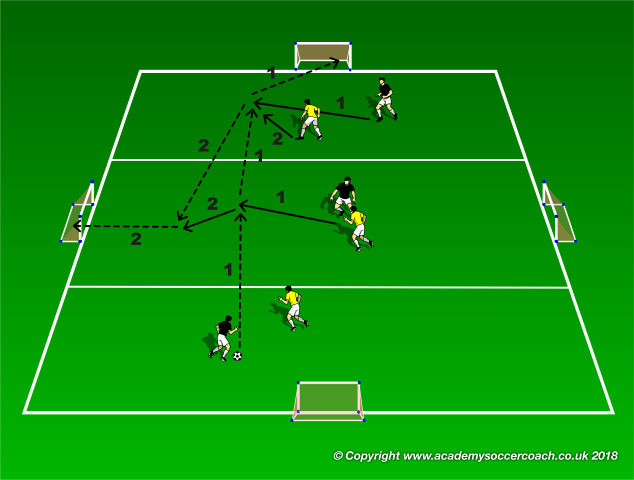
Set-up and Sequence: a 3 v 3 duel is played inside a rectangular space that is divided into three areas horizontally; a 1 v 1 duel is played inside each zone. 4 mini-goals are placed in the center of each side, as in the picture.
The goal for the possession team is to play the ball vertically to finish in one of the mini-goals that are placed on the shorter sides of the main rectangle (num. 1).
If the defenders win the ball, they must finish in one of the wide mini-goals that are placed along the longer sides of the structure (num.2).
Eye on: quick passes combinations, escape the marker, oriented ball control, and receive on the run.
4 v 4 Exercises (1)
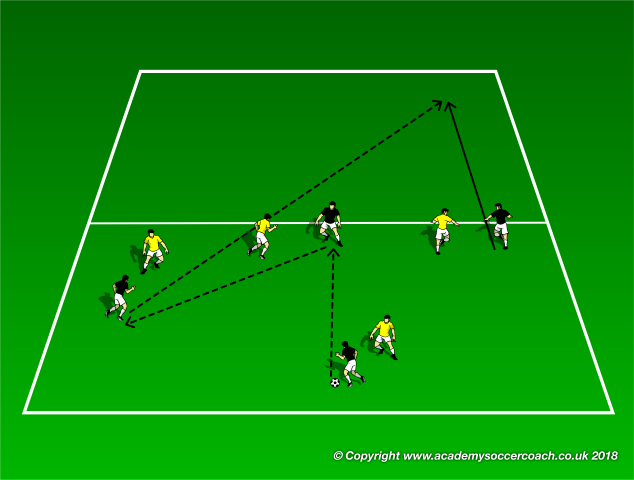
Set-up and Sequence: a 4 v 4 duel is played inside a rectangular space that is divided into two areas horizontally; all the players are placed inside one of the halves as in the picture.
The goal for the possession team is to play toward the opposite zone, where a teammate must receive on the run, when three players have touched the ball.
If the defenders win the ball, they must play the same way.
Variations: if the defenders win the possession, a 4 v 4 free duel is played all over the space.
Eye on: quick passes combinations, escape the marker with the right timing.
4 v 4 Exercises (2)
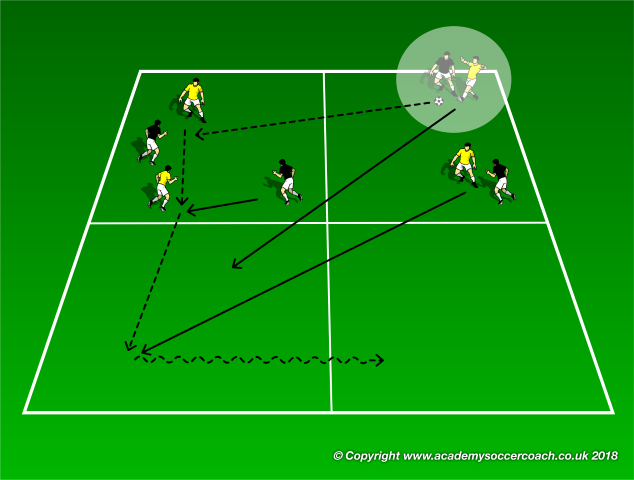
Set-up and Sequence: a 4 v 4 duel is played inside a rectangular space that is divided into four areas horizontally and vertically. The black players must follow the horizontal division of the pitch; the yellow ones must follow the vertical one.
The goal for the possession team is to play toward the opposite zone where a teammate must receive on the run, when three players have touched the ball.
If the defenders win the ball, they must play the same way, but from the left to the right side, vice versa, after positioning the team, as in the picture.
Eye on: quick passes combinations, escape the marker with the right timing, replace in the pitch quickly.
4 v 4 Exercises (3)
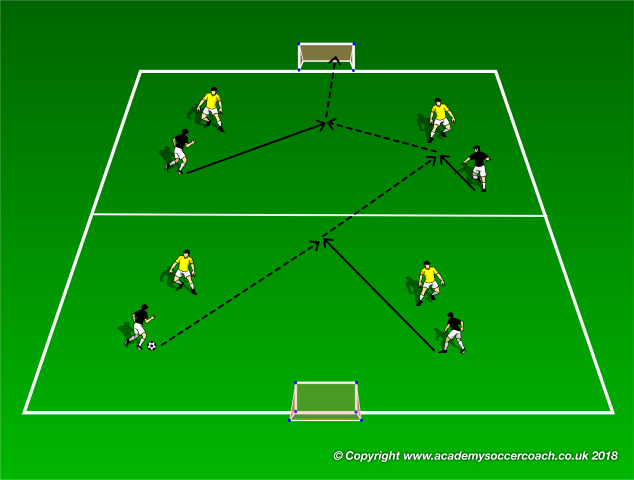
Set-up and Sequence: a 4 v 4 duel is played inside a rectangular space that is divided into two areas horizontally; a 2 v 2 duel is played inside each half.
The goal for the possession team is to play toward the opposite zone to finish, winning the duel inside each area to build up first and then to shoot.
If the defenders win the ball, they must play the same way toward the opposite side.
Variations: if the defenders win the possession, a 4 v 4 free duel is played to counter attack.
Eye on: play behind the opponents, escape the marker with the right timing, and finish quickly.
4 v 4 Exercises (4)
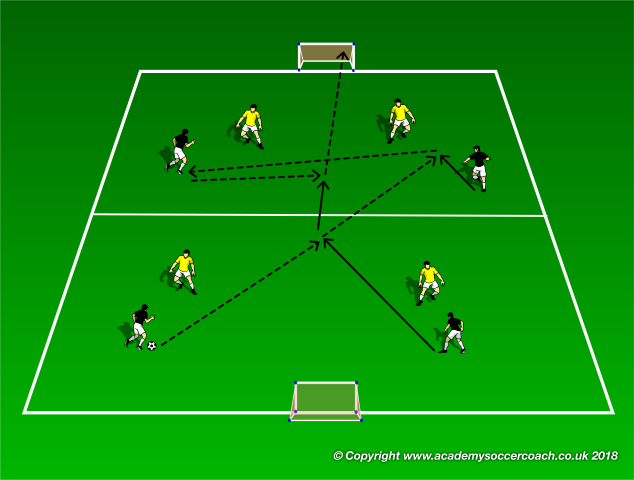
Set-up and Sequence: this exercise is a progression of the previous one.
As the ball is played inside the forward half of the pitch, a momentary numerical advantage (3 v 2 for 5"/10") is created inside the finishing area. After this time, the equal number of players must be re-form.
If the defenders win the ball, they must play the same way toward the opposite side.
Variations: if the defenders win the possession, a 4 v 2 duel is played to counter attack.
Eye on: play behind the opponents, exploit the numerical advantage to finish quickly.
4 v 4 Exercises (5)
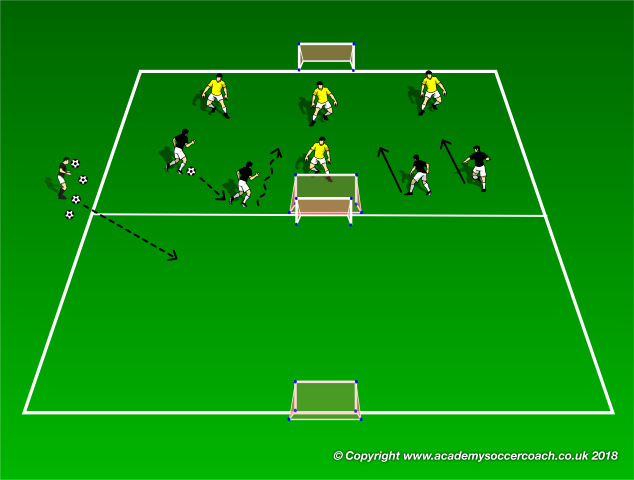
Set-up and Sequence: a 4 v 4 duel is played inside a rectangular space that is divided into 2 areas horizontally; all the players are placed inside one of the halves in the picture as well as and four mini goals.
Both the teams have one goal to defend and one goal to attack inside each half.
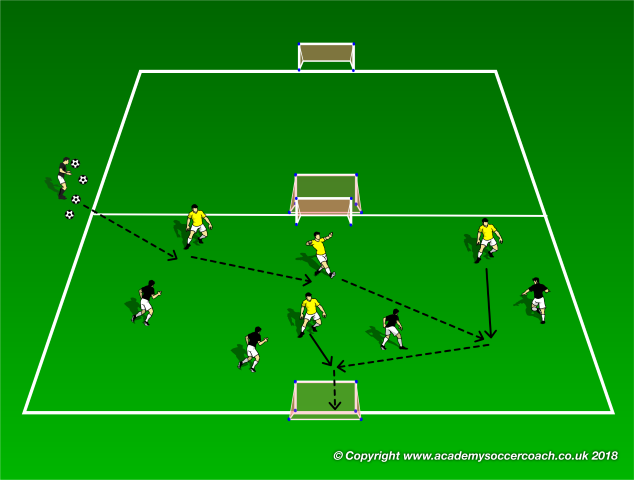
The coach can decide to play a ball inside the other half. From this moment the roles of the teams are inverted; the defending team becomes the attacking team and vice versa.
Variation: the coach plays the ball toward the opposite side and the roles on the pitch are the same.
Eye on: quick transition to attack and to defend, quick positioning.


